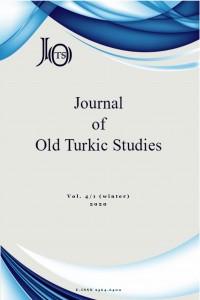Research Article
Year 2020,
Volume: 4 Issue: 1, 28 - 38, 29.01.2020
Abstract
The
term of impersonal verb to be used to describe the verbs that do not need any
subject to be realized. Until this time, there is no an examine in details
about condition of impersonal verbs in Turkish. The reason for this is based on
the idea that impersonal verbs are not available in Turkish. However, the
results of this article has been revealing that previously mentioned the idea
should be criticized. The topic was handled around three important questions:
What is impersonal verb? What is the reason for being of impersonal verbs? Are
impersonal verbs available in Turkish? We think, the answers given to these
questions will contribute to both theoretical linguistics and grammar studies
of Turkish.
term of impersonal verb to be used to describe the verbs that do not need any
subject to be realized. Until this time, there is no an examine in details
about condition of impersonal verbs in Turkish. The reason for this is based on
the idea that impersonal verbs are not available in Turkish. However, the
results of this article has been revealing that previously mentioned the idea
should be criticized. The topic was handled around three important questions:
What is impersonal verb? What is the reason for being of impersonal verbs? Are
impersonal verbs available in Turkish? We think, the answers given to these
questions will contribute to both theoretical linguistics and grammar studies
of Turkish.
Keywords
References
- ADIVAR, A. (2000). Tarih Boyunca İlim ve Din, 3. Baskı, İstanbul: Remzi Kitabevi.
- AKDERİN, F. (2015). Platon: Timaios, Ankara: Say Yayınları.
- ARSLAN, A. (2016). İlkçağ Felsefe Tarihi: Aristoteles III, 5. Baskı, İstanbul: İstanbul Bilgi Üniversitesi Yayınları.
- ATALAY, B. (1985). Divanü Lûgat-it-Türk Tercümesi II, Ankara: Türk Dil Kurumu Yayınları.
- AYTAÇ, G. (2011). Klasik Alman Dil Felsefesi Metinleri: Herder, Fichte ve Humboldt, Ankara: Phoenix Yayınevi.
- BABÜR, S. (2005). Aristoteles: Fizik, 3. Baskı, İstanbul: Yapı Kredi Yayınları.
- CLAUSON, Sir G. (1972). An Etymological Dictionary of Pre-Thirteenth Century Turkish, Oxford: Oxford University Press.
- DANKOFF, R. & J. KELLY (1984). Mahmut el-Kāşгarī: Compendium of the Turkic Dialects (Dīvān Luγāt at-Türk) II, Harvard: Harvard University Press.
- DENİZ YILMAZ, Ö. (2012). “Türkçe Kelime Çekimi Ulamları Dizgesi Üzerine: Fiil Çekimi Ulamları”, Dil Araştırmaları, 11: 105-129.
- ERCİLASUN, A. B. & Z. AKKOYUNLU (2014). Kâşgarlı Mahmud: Dîvânu Lugâti’t-Türk, Giriş-Metin-Çeviri-Notlar-Dizin, Ankara: Türk Dil Kurumu Yayınları.
- ERDEM, M. & G. COSUN (2013). “Divânü Lügâti’t-Türk’te Ettirgen Yapılar”, Kahraman Maraş Sütçü İmam Üniversitesi Sosyal Bilimler Dergisi, 10/1: 49-58.
- IŞIK, G. (2012). “L. Tesniere’in Yapısal Sözdizimine Göre İtalyanca ve Türkçede Eylem Yapılarının Karşılaştırılması”, Dilbilim, 6: 71-83.
- KALYUTA, A. (2004). Dil Bilimi Terimleri Sözlüğü, İstanbul: Multilingual Yayınları.
- KARABACAK, E. (2002). Bergamalı Kadri: Müyessiretü’l-Ulûm: Giriş-Metin-Sözlük-Terimler Dizini-Tıpkı Basım, Ankara: Türk Dil Kurumu Yayınları.
- ULAŞ, S. E. (2002). Felsefe Sözlüğü, Haz. A. BÂKİ GÜÇLÜ et al., Ankara: Bilim ve Sanat Yayınları.
- ÜLKEN, H. Z. (1953). “Cemiyet ve Dil (Dil Araştırmalarına Rehber Olmak Bakımından)”, Türk Dili Araştırmaları Yıllığı Belleten 1953: 29-44.
Year 2020,
Volume: 4 Issue: 1, 28 - 38, 29.01.2020
Abstract
The term of
impersonal verb to be used to describe the verbs that do not need any subject
to be realized. Until this time, there is no an examine in details about
condition of impersonal verbs in Turkish. The reason for this is based on the
idea that impersonal verbs are not available in Turkish. However, the results
of this article has been revealing that previously mentioned the idea should be
criticized. The topic was handled around three important questions: What is
impersonal verb? What is the reason for being of impersonal verbs? Are
impersonal verbs available in Turkish? We think, the answers given to these
questions will contribute to both theoretical linguistics and grammar studies
of Turkish.
Keywords
References
- ADIVAR, A. (2000). Tarih Boyunca İlim ve Din, 3. Baskı, İstanbul: Remzi Kitabevi.
- AKDERİN, F. (2015). Platon: Timaios, Ankara: Say Yayınları.
- ARSLAN, A. (2016). İlkçağ Felsefe Tarihi: Aristoteles III, 5. Baskı, İstanbul: İstanbul Bilgi Üniversitesi Yayınları.
- ATALAY, B. (1985). Divanü Lûgat-it-Türk Tercümesi II, Ankara: Türk Dil Kurumu Yayınları.
- AYTAÇ, G. (2011). Klasik Alman Dil Felsefesi Metinleri: Herder, Fichte ve Humboldt, Ankara: Phoenix Yayınevi.
- BABÜR, S. (2005). Aristoteles: Fizik, 3. Baskı, İstanbul: Yapı Kredi Yayınları.
- CLAUSON, Sir G. (1972). An Etymological Dictionary of Pre-Thirteenth Century Turkish, Oxford: Oxford University Press.
- DANKOFF, R. & J. KELLY (1984). Mahmut el-Kāşгarī: Compendium of the Turkic Dialects (Dīvān Luγāt at-Türk) II, Harvard: Harvard University Press.
- DENİZ YILMAZ, Ö. (2012). “Türkçe Kelime Çekimi Ulamları Dizgesi Üzerine: Fiil Çekimi Ulamları”, Dil Araştırmaları, 11: 105-129.
- ERCİLASUN, A. B. & Z. AKKOYUNLU (2014). Kâşgarlı Mahmud: Dîvânu Lugâti’t-Türk, Giriş-Metin-Çeviri-Notlar-Dizin, Ankara: Türk Dil Kurumu Yayınları.
- ERDEM, M. & G. COSUN (2013). “Divânü Lügâti’t-Türk’te Ettirgen Yapılar”, Kahraman Maraş Sütçü İmam Üniversitesi Sosyal Bilimler Dergisi, 10/1: 49-58.
- IŞIK, G. (2012). “L. Tesniere’in Yapısal Sözdizimine Göre İtalyanca ve Türkçede Eylem Yapılarının Karşılaştırılması”, Dilbilim, 6: 71-83.
- KALYUTA, A. (2004). Dil Bilimi Terimleri Sözlüğü, İstanbul: Multilingual Yayınları.
- KARABACAK, E. (2002). Bergamalı Kadri: Müyessiretü’l-Ulûm: Giriş-Metin-Sözlük-Terimler Dizini-Tıpkı Basım, Ankara: Türk Dil Kurumu Yayınları.
- ULAŞ, S. E. (2002). Felsefe Sözlüğü, Haz. A. BÂKİ GÜÇLÜ et al., Ankara: Bilim ve Sanat Yayınları.
- ÜLKEN, H. Z. (1953). “Cemiyet ve Dil (Dil Araştırmalarına Rehber Olmak Bakımından)”, Türk Dili Araştırmaları Yıllığı Belleten 1953: 29-44.
There are 16 citations in total.
Details
| Primary Language | Turkish |
|---|---|
| Subjects | Language Studies |
| Journal Section | Articles |
| Authors | |
| Publication Date | January 29, 2020 |
| Published in Issue | Year 2020 Volume: 4 Issue: 1 |

